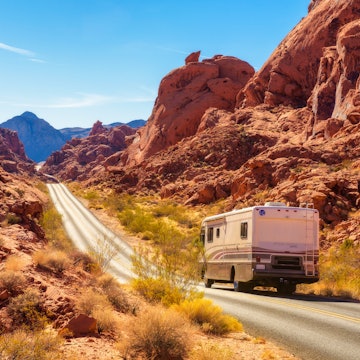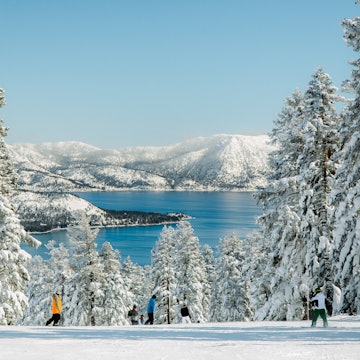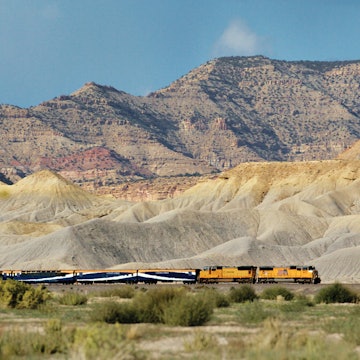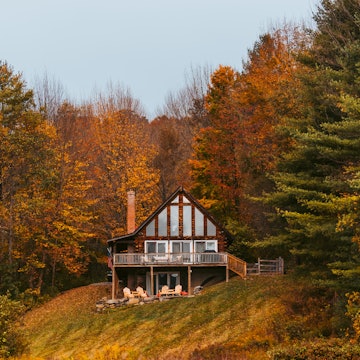

Eroded rock formations at Badlands National Park. EQRoy/Shutterstock
Badlands National Park in South Dakota is one of the most rewarding places to visit in the state. Its surreal landscapes were created over millions of years, as rivers raged and winds gusted, depositing layer upon layer of rock until buttes and spires pointed toward the sky. Each layer is a different hue as if painted into stripes of yellow, orange, purple, gray and tan. It’s the kind of place that makes you gasp out loud. Next comes silence as you soak it all in.
The Lakota called this region mako sica which means "bad lands." It’s a fitting name for such a daunting place. The winters are cold and stormy, the summers are dry and hot, and canyons and buttes have created an unforgiving maze. Archaeological evidence suggests the Lakota hunted here seasonally without establishing a permanent habitat.
The Badlands were authorized as a national monument in 1929 and officially designated a national park in 1978, ensuring that 244,000 acres of otherworldly rock formations, prairies, wildlife and one of the world’s most abundant fossil beds would be preserved and protected.
Start planning your trip to Badlands with this guide, but before visiting any US national park, visitors should be aware that staffing cuts in the National Park Service (NPS) are having an impact on the amenities available.

When should I go to Badlands National Park?
Badlands National Park is open 24 hours a day, 365 days a year. In summer, temperatures rise as high as 114°F (45°C). This is the time of year when the park is busiest (although with 244,000 acres, it rarely feels crowded). If you plan to engage in outdoor recreation, carry plenty of water and head out in the morning before it gets too hot. Monitor the weather and schedule activities like scenic drives and trips to visitor centers during the hottest parts of the day so you’ll have air-conditioning to cool you down.
In winter, Badlands National Park receives up to two feet of snow. Average high temperatures are 35°F (2°C); average lows are around 17°F (-8°C). Gear up for extreme cold and check the NPS website for up-to-date information on road closures and driving conditions before your visit.
The April/May or September/October shoulder seasons are the best times to visit Badlands National Park. Temperatures are mild, and the park is generally uncrowded. September is especially rewarding with temperatures up to the mid-70s (23°C) and relatively few visitors after Labor Day.

How much time should I spend in Badlands National Park?
Plan to budget two to three days for your trip to Badlands National Park. That said, even day trips are worthwhile. If you only have a few hours, concentrate on scenic drives with stops at overlooks to gape at the views. If you’re lucky enough to have a few days at Badlands National Park, spend your time hiking, viewing wildlife and exploring the visitor centers.
Is it easy to get in and around Badlands National Park?
Despite looking like another planet, the Badlands are easy to reach. The park is about an hour’s drive from Rapid City Regional Airport, which services several major airlines.
If you’re traveling in a car or RV, Badlands National Park is 62 miles from Rapid City, 276 miles from Sioux Falls, 370 miles from Denver and 450 miles from Omaha. If you're on a road trip, check out these roadside attractions, including Wall Drug Store, about 11 minutes from the park's Pinnacles Entrance Station.
There isn’t any public transportation or a shuttle system inside the park, so you’ll need a personal vehicle to explore the Badlands. Cell service is spotty, and there may be times when GPS is unavailable, so download your maps in advance or bring paper copies.
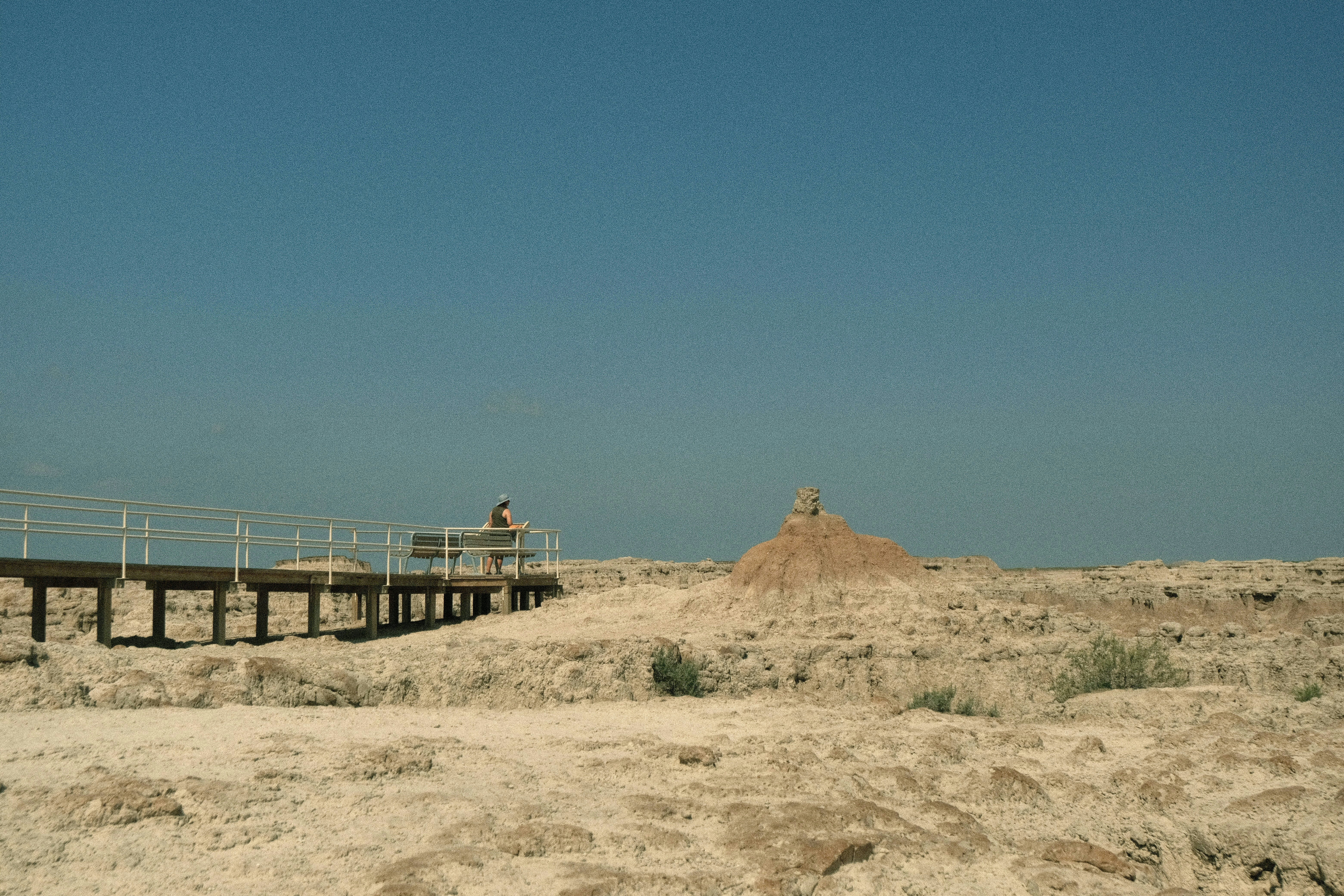
Is Badlands National Park accessible?
Badlands National Park is committed to creating an accessible environment for all visitors. Wheelchair-accessible boardwalks meander through grasslands and staggering, beautiful stone formations to overlook vistas throughout the park. In addition, the Fossil Exhibit Trail includes tactile exhibits and braille on its interpretive signs.
Both visitor centers are wheelchair-accessible. Open-captioned and audio-described versions of the introductory park film are available upon request. At the Ben Reifel Visitor Center, museum exhibits contain tactile and audiovisual elements to assist guests who are blind or visually impaired.
Cedar Pass Campground offers two wheelchair-accessible campsites, plus an accessible site in the group loop area.

Top things to do in Badlands National Park
Tour a world of prairie and stone
Part of the allure of Badlands National Park is the dramatic way the landscape shifts from one section to the next. You need merely turn a corner to catch a glimpse of bighorn sheep grazing by the side of the road or an ocean of stone waves disappearing into infinite stretches of grass.
For wildlife viewing, try the Sage Creek Rim Rd, a dirt road through the Sage Creek Wilderness Area, where you’re most likely to spot bison. Other wildlife in Badlands National Park includes elk, mountain lions, pronghorn, rattlesnakes and dozens of bird species.
The most popular drive in the park is Hwy 240 Badlands Loop Rd, the park’s main thoroughfare. This drive carries you through spectacular scenery, winding past prairies, pyramid-shaped rock formations, overlooks and visitor centers.
Geek out on fossils
We know ancient horses, rhinos, camels, tigers and oreodonts once roamed the Badlands thanks to a wealth of fossils. New evidence of prehistoric life is constantly being discovered at the park, often by visitors who alert park rangers so the find can be meticulously uncovered and preserved. The fascinating quarter-mile wheelchair-accessible Fossil Exhibit Trail features fossil replicas and displays of the ancient animals that once called the Badlands home.
The Ben Reifel Visitor Center is home to the Fossil Preparation Lab, where you can watch paleontologists at work and ask questions about ancient life and projects at the park. The lab is usually open from 9am to 4:30pm every day of the week.
Go stargazing
A lack of light pollution transforms the night sky at Badlands National Park into millions of diamonds flickering in the wilderness. Stargazing is incredible year-round, but if you happen to be visiting from Memorial Day through Labor Day, rangers set up telescopes and give astronomy talks after sunset at the Cedar Pass Campground Amphitheater.

Take a hike
In addition to the wheelchair-accessible boardwalks scattered throughout the park, longer, more challenging trails include the 10-mile out-and-back Castle Trail, which starts at the Door and Window Parking Area and weaves through grasslands and rock formations before ending at the Fossil Exhibit Trail.
Off-trail hiking is permitted at Badlands National Park. Should you venture off-trail, be sure to carry plenty of water, stay at least 100ft away from wildlife and wear boots or sturdy shoes for protection from snakes and cacti.
Pay a call to the visitor centers
Stop by the Ben Reifel Visitors Center at Badlands National Park to see museum exhibits and fossils and chat with park rangers and paleontologists. The White River Visitor Center is dedicated to the Badland’s cultural heritage. Rangers are on hand to give talks and showcase exhibits about the park’s significance to the Lakota people.

My favorite thing to do at Badlands National Park
I can’t get enough sunsets at Badlands National Park. In the evening, the sun melts against the horizon like a ball of fiery wax, pouring color across the buttes, pinnacles and spires. The entire park seems to hum and glow as it absorbs the fading light. Sunrises are equally beautiful, especially if you’re visiting in summer and want to start your day before it gets too hot.
The best places to catch the sunset are Pinnacles Overlook, Conata Basin Overlook, and the Bigfoot Pass Picnic Area. Enjoy the sunrise at Panorama Point Overlook, Door Trail and Big Badlands Overlook.
How much money do I need for Badlands National Park?
Basic hotel room for two in Rapid City: $99 to $175
Room or cabin inside Badlands National Park at Cedar Pass Lodge: from $249 per night
Camping in Badlands National Park at Sage Creek Campground: free
Camping in Badlands National Park at Cedar Pass Campground: from $37 per night
Meal for two at Cedar Pass Lodge Restaurant: $40 to $50
Souvenir T-shirt from Ben Reifel Visitor Center: from $25
Park entrance fee: standard entrance $15 to $30; annual entrance $55; America the Beautiful Pass free to $80









